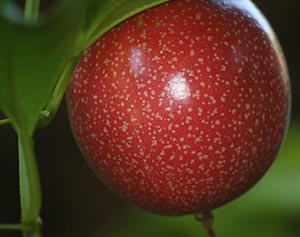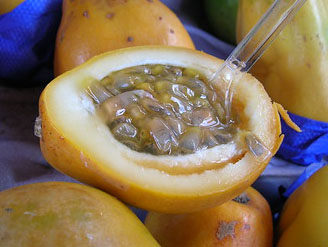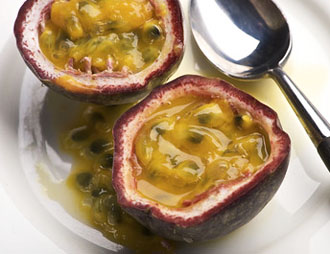Passion fruit nutrition facts
Pleasantly sweet and tart, Passion fruit, also known as granadilla, is brimming with many plant-derived nourishing essentials offering optimum health. Passions are native to subtropical wild regions of South America, and probably originated in Paraguay. It is an avid climber (vine) that grows on anything that it can grapple around through its tendrils.
Botanically, this exotic fruit belongs to the family of Passifloraceae, of the genus; Passiflora. Scientific name: Passiflora edulis.
 |
| Passion fruit. Note oval-shaped ripening fruit with a smooth waxy surface and fine white specks. (Photo by jemasmith) |
The passiflora plant requires well-drained fertile soil and good moisture to flourish. Once established, it grows quickly and reaches about 15-20 feet per year. The plant has an average lifespan of about 5-7 years.
Over five hundred cultivar types of passions exist; however, only two main types, purple and yellow varieties, are widely grown.
Banana passionfruit (P. tripartita var. mollissima), known locally as Curuba de Castilla, features a small banana-like shape with round ends. During each season, the vine bears greenish-white fragrant flowers which subsequently develop into fruits.
 |
| Golden yellow passion fruit. Note for the thick rind. Inside showing pulpy juice with numerous tiny, dark brown or black, pitted seeds. (Photo by Vic Lic) |
Passion fruit features a round to oval shape, 4 to 8 centimeters in diameter, and has a tough outer shell (rind) as that of in mangosteen. Average weight is about 35-50 g.
Inside, the fruit consists of membranous sacs containing light orange color, thick juice with numerous small, hard, dark-brown or black, pitted seeds. Yellow passions are larger than the purple varieties, but the pulp of the purple fruit is less acidic, richer in aroma and flavor, and has a higher proportion of juicy pulp.
8 amazing Health benefits of Passion fruit
Passion fruit is a rich source of antioxidants, minerals, vitamins, and fiber. 100 g (3oz) fruit holds about 97 calories.
It is an excellent source of dietary fiber. 100 g fruit contains 10.4 g or 27% of fiber. A sufficient amount of fiber in the diet helps in controlling blood cholesterol and weight reduction. Being a bulk laxative, it also helps protect the colon mucosa by wiping off any cancer-causing toxic substances from the colon.
Passion fruit is good in vitamin-C, provides about 30 mg per 100 g. Vitamin C (ascorbic acid) is a powerful water-soluble antioxidant.
Consumption of fruits rich in vitamin C helps scavenge harmful, pro-inflammatory free radicals by virtue of its antioxidant properties. Vitamin C also boosts immunity to fight against flu infections.
The fruit carries excellent levels of vitamin-A (provides about 1274 IU per 100 g), and flavonoid antioxidants such as ß-carotene and cryptoxanthin-ß. Current research studies suggest that these compounds possess antioxidant properties, and together with vitamin-A work help protect the retina. it is also an essential vitamin for good eyesight.
Vitamin A is also required for maintaining healthy hair, mucosa, and skin. Consumption of natural fruits rich in vitamin A and flavonoids may offer protection against lung and oral cavity cancers.
Fresh granadilla is a very rich source of potassium. 100 g fruit pulp has about 348 mg of potassium. Potassium is a major component of cells and body fluids and helps regulate heart rate and blood pressure.
Furthermore, granadilla is an excellent source of minerals. Iron, copper, magnesium, and phosphorus are present in adequate amounts in the fruit.
| Principle | Nutrient Value | Percent of RDA |
|---|---|---|
| Energy | 97 Kcal | 5% |
| Carbohydrates | 23.38 g | 18% |
| Protein | 2.20 g | 4% |
| Total Fat | 0.70 g | 3% |
| Cholesterol | 0 mg | 0% |
| Dietary Fiber | 10.40 g | 27% |
| Vitamins | ||
| Folates | 14 μg | 3% |
| Niacin | 1.500 mg | 9% |
| Pyridoxine | 0.100 mg | 8% |
| Riboflavin | 0.130 mg | 10% |
| Thiamin | 0.00 mg | 0% |
| Vitamin A | 1274 IU | 43% |
| Vitamin C | 30 mg | 50% |
| Vitamin E | 0.02 μg | <1% |
| Vitamin K | 0.7 mg | 0.5% |
| Electrolytes | ||
| Sodium | 0 mg | 0% |
| Potassium | 348 mg | 7% |
| Minerals | ||
| Calcium | 12 mg | 1.2% |
| Copper | 0.086 mg | 9.5% |
| Iron | 1.60 mg | 20% |
| Magnesium | 29 mg | 7% |
| Phosphorus | 68 mg | 10% |
| Selenium | 0.6 µg | 1% |
| Zinc | 0.10 mg | 1% |
| Phyto-nutrients | ||
| Carotene-ß | 743 µg | -- |
| Crypto-xanthin-ß | 41 µg | -- |
| Lycopene | 0 µg | -- |
Selection and storage
Passion fruits can be available year-round in supermarkets in the United States. In other parts of the world, their availability is seasonal and varies accordingly. In New Zealand, the passion fruit season begins in January, and peaks in April.
In the stores, buy fruits that are well-ripe, plump, and heavy for their size. Fruits with wrinkled surfaces are more flavorful and rich in sugar.
Avoid overtly mature fruits. Minor cuts and spots are common on the skin. Such small abrasions on the fruit surface usually do not influence the quality of the fruit.
Once at home, keep them in a fruit basket and place them in a cool dark place where they stay well for 1-2 days. Ripe fruits may be maintained in the refrigerator for up to one week. Additionally, passion fruit freezes well. Simply scoop the pulp into a bowl, add a little sugar, and freeze in the chiller tray.
Preparation and serving method
 |
| Cut section of passion-granadilla fruit. (Photo by geishaboy500) |
Wash fruit in cold water and pat dry them using a soft cloth or paper. Cut the fruit lengthwise into two halves. Then, scoop out the juicy pulp with a spoon. Discard the tough shell.
Passion fruits have a unique tart pleasant flavor and sweet taste. Purple passion fruits are smaller but more flavorful than yellow-golden passions.
Here are some serving tips:
Passion fruit can be enjoyed fresh, especially when the fruit is well-ripe. Just scoop out its juicy pulp using a spoon. Its tough shell, anyhow, is inedible.
Their juicy pulp can also be enjoyed as a refreshing intra-day drink.
Passions add a distinct flavor to fruit salads.
Passions used in the preparation of sauce, jellies, and syrups.
It employed in various recipes like passion fruit mousse, ice-cream, pizza, desserts, cakes, mousse…etc.
≻≻-Back to Fruits from Passion fruit. Visit here for an impressive list of all varieties of fruits with complete illustrations of their nutrition facts and health benefits.
≻≻-Back to Home page.
Further reading and Resources:
USDA National Nutrient Database. (opens in new window)
Stanford School of Medicine Cancer information Page-Nutrition to Reduce Cancer Risk (Link opens in new window).
Passionfruit information - http://www.passionfruit.org.nz/.